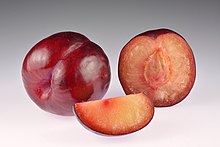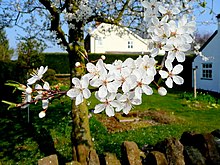**History and Origin**:
– Plums may have been one of the first fruits domesticated by humans.
– Plum remains found in Neolithic age archaeological sites.
– Plums originated in Iran according to Ken Albala.
– Plum tree cultivation documented in 12th-century Andalusia.
**Etymology and Names**:
– Name ‘plum’ derived from Old English, Germanic, and Latin.
– Late 18th century use of ‘plum’ to indicate something desirable.
**Description and Cultivation**:
– Plums are a diverse group of species.
– Commercially important plum trees are medium-sized.
– Plum trees blossom in different months worldwide.
– Fruits are medium-sized, with smooth peel and firm flesh.
– Plum is a drupe with a single hard fruitstone.
– China is the largest producer of plums.
– Japanese or Chinese plums dominate the fresh fruit market.
– Plum kernels contain cyanogenic glycosides.
– Plums can be eaten fresh, dried, used in jams, or fermented.
– Plum wine and brandy are made from plums.
**Nutritional Value**:
– Raw plums are 87% water, 11% carbohydrates.
– Plums are a moderate source of vitamin C.
– Plum kernels are not commercially available for oil extraction.
– Plums do not contain significant amounts of other micronutrients.
**Production and Species**:
– Global production of plums in 2019 was 12.6 million tonnes.
– China led the production with 56% of the world total.
– Romania and Serbia were secondary producers.
– Plum species are classified into different sections.
– Only two plum species, European plum and Japanese plum, have worldwide commercial significance.
– Plum species have originated in Europe, Asia, and America.
A plum is a fruit of some species in Prunus subg. Prunus. Dried plums are most often called prunes, though in the United States they may be just labeled as 'dried plums', especially during the 21st century.



Plums may have been one of the first fruits domesticated by humans, with origins in East European and Caucasian mountains and China. They were brought to Britain from Asia, and their cultivation has been documented in Andalusia, southern Spain. Plums are a diverse group of species, with trees reaching a height of 5–6 metres (16–20 ft) when pruned. The fruit is a drupe, with a firm and juicy flesh.
China is the largest producer of plums, followed by Romania and Serbia. Japanese or Chinese plums dominate the fresh fruit market, while European plums are also common in some regions. Plums can be eaten fresh, dried to make prunes, used in jams, or fermented into wine and distilled into brandy. Plum kernels contain cyanogenic glycosides, but the oil made from them is not commercially available.
In terms of nutrition, raw plums are 87% water, 11% carbohydrates, 1% protein, and less than 1% fat. They are a moderate source of vitamin C but do not contain significant amounts of other micronutrients.
